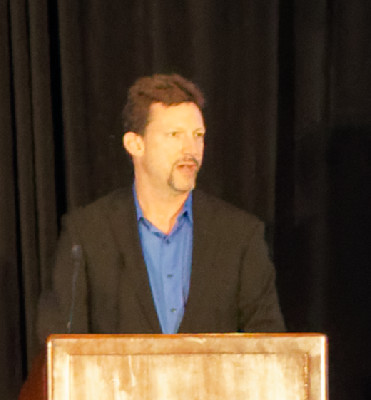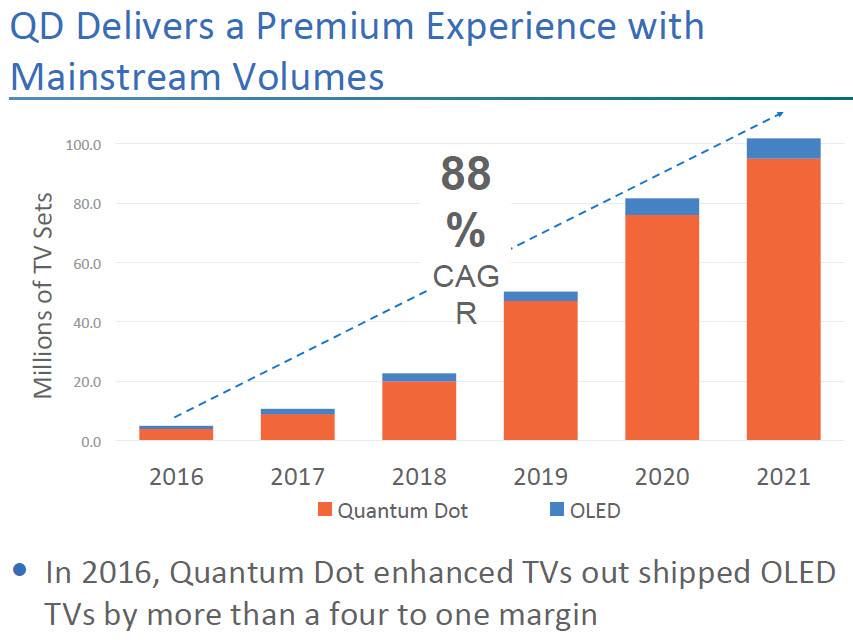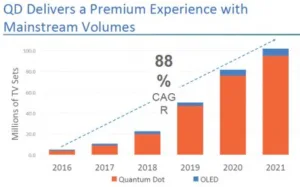 We have reported talks by Jason Hartlove, CEO of Nanosys, many times. He, of course talked about Quantum Dots.
We have reported talks by Jason Hartlove, CEO of Nanosys, many times. He, of course talked about Quantum Dots.
Nanosys makes quantum dot materials and can make high efficiency materials that are tunable to any colour. The company is in Silicon Valley and started in 2001. The firm has been making sales in ‘$10s of millions’ and has many products based on its materials (60 or so) in the market. It is profitable and invests those profits back in the business.
QDs have already become a mainstream category, now. There are about four times as many QD TVs being sold compared to OLED TVs. In 2017, the area of QDs will be around six times the area of all OLEDs at 122 million m² compared to 20 million m².

Currently, QDs are used for colour conversion (which Hartlove calls colour enhanced) and next will be photoemissive. Finally, the company is aiming at electro-emissive. The photoemissive stage is where the QDs are put in the filter (as Hartlove revealed at the SID Business Conference last year) Hartlove said that QD in the filter could get to 5,000 cd/m² of output luminance.
The photo-emissive use of QDs improves the viewing angle of LCDs as the red and green light is an emissive layer (later, in the booth, we heard that an optical element is used for the blue to achieve the same viewing angle.) The same approach could be used for microLED which struggles with colour uniformity over large areas and Nanosys thinks that there could be a big opportunity to use just blue LEDs with QDs to convert the colour to red and green for microLEDs.
Nanosys has been working on photoresists and inkjet materials that could be used in materials for photo-emissive use. The blue absorption has to be very high to ensure that there is little or no leakage of blue light through the filter-like structure.
In electroemissive use, the material is used in an ‘OLED-like’ stack to create very accurate colours with high efficiency. The key advantage of QD in this application is that the materials are easier to handle than current OLEDs. Nanosys can use screen printing to make this kind of display, Hartlove said. That would be very low cost compared to other approaches. (BOE was showing an electro-emissive QD display made by inkjet printing on the show floor, althought it was some way from being good enough for a commercial product – Man. Ed.)
OLED is struggling to get to processes with high efficiency. LED displays are expensive to make. However, Hartlove said that the QD materials are at around >10% EQE using a cadmium-free with blue output.
 Nanosys sees QD Electro emissive as having huge potential
Nanosys sees QD Electro emissive as having huge potential
Hartlove concluded by saying that photoemissive products could be in the market by 2018 and by 2020/2021 there could be electro-emissive products starting to appear.
Analyst Comment
Hartlove’s comment about the >10% external quantum efficiency (EQE) was given in a very neutral way. However, we later heard that other researchers are at just 0.5% or 1%, so more than 10% is a genuinely big deal! (BR)

